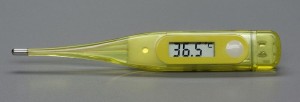FRIDAY, 7 JANUARY 2011
The model, developed by two researchers at Yeshiva University in New York, balances the benefit of an increased body temperature, which reduces the risk of fungal infection, with the associated cost of the higher metabolic rate required to maintain that body temperature. Their model indicates that 36.7°C is the optimum body temperature. This agrees closely with the normal body temperature of mammals and is further supported by the fact that tens of thousands of fungal species infect cold-blooded animals but only a few hundred harm mammals.Interestingly, the model only relies on one parameter from biological observation: the temperature dependence of the number of fungal species capable of infecting a host. Earlier work had suggested that the number of species declines by 6% for every 1°C rise in temperature, but even allowing for a species decline of between 4% and 8%, the optimal temperature was still found to be between 37.7°C and 35.9°C.
This simple model suggests that warm-bloodedness may have evolved to optimise a trade-off between metabolic costs and the increased fitness that comes with resistance to fungal diseases. It has also been proposed that this resistance could have contributed to the success of mammals relative to that of other vertebrates after the fall of the dinosaurs.
Further details of the model can be found in the published paper.
Written by Katy Wei

